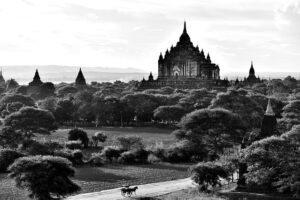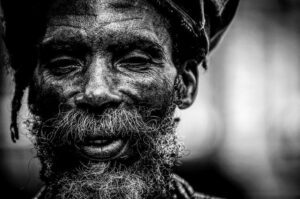- Photography Process
- Portrait Photography
- Commercial Photography
- Product Photography
- Fine Art Photography
- Editorial Photography
- Conceptual Photography
- Stock Photography
- Soft Focus Photography
- How To Shoot Film Photography
- Short Lighting Photography
- Split Lighting Photography
- Side Lighting In Photography
- Creative Photography Ideas
- 200+ More Photography Guides
At its core, photojournalism is storytelling with a camera, capturing moments that illustrate the essence of an event or issue.
It’s a powerful form of journalism that conveys stories through images, often more poignantly than words alone could.
In this article, we’ll explore the ins and outs of photojournalism, from its history to its impact on society.
We’re diving into the role of photojournalists and how their work shapes our understanding of the world.
History Of Photojournalism
The birth of photojournalism parallels advances in technology and societal shifts.
Its roots can be traced back to the 19th century when photographers began capturing pivotal moments in history.
Initial photographs were more of a curiosity rather than a means to tell a story due to the long exposure times required.
The 20th century turned the tide for photojournalism.
Faster shutter speeds and portable cameras such as the Leica made it possible to photograph subjects in motion or in less than ideal conditions.
It’s during this time that photojournalism became an influential force.
Notable moments captured included battlefield actions and human struggles during the World Wars which brought unfiltered realities into public view.
Iconic publications embodied the spirit of photojournalism:
- Life Magazine – pioneering photo essays that illustrated global events and daily life,
- The Illustrated London News – the world’s first illustrated weekly news magazine.
These publications demonstrated the public’s hunger for visual narratives.
Photographers like Dorothea Lange with her image Migrant Mother and Joe Rosenthal with Raising the Flag on Iwo Jima not only provided visual accounts but also elicited emotional responses that shaped public opinion.
As technology continued to evolve, so did the means of sharing visual stories.
The introduction of televised news and the Internet brought new challenges and opportunities.
The immediacy and distribution power of digital media have since revolutionized our consumption of photographic journalism.
This shift has immensely widened the audience and reach of the stories told through photojournalism.
The digital era ushered in user-generated content and social media, further expanding the landscape of photojournalism.
Every smartphone user became a potential photojournalist, capturing live events as they unfold.
This democratization of the medium has sparked discussions about authenticity, ownership, and the future role of professional photojournalists.
We acknowledge the undeniable impact of photojournalism on our collective consciousness.
Individual photographs have changed laws, swayed public opinion, and immortalized moments in history.
As we continue to navigate through a world inundated with images, the enduring power of photojournalism remains clear – photographs command our attention and often, our hearts.
Elements Of Photojournalism
In the rich tapestry of photojournalism, certain elements are pivotal to the craft.
For us at Filmmaking Lifestyle, it’s essential to recognize these components that resonate with audiences and validate the significance of a photograph within its historical and cultural context.
Photojournalism isn’t just about taking pictures – it’s a form of storytelling where imagery embodies the narrative.
Here are key elements that elevate photography into photojournalism:
- Timeliness – the image must be relevant to current events or stories.
- Objectivity – the photo should represent the subject honestly, without bias.
- Narrative – it should convey a story, often as part of a larger ongoing event.
- Subjectivity – while objectivity is important, the photographer’s perspective can add depth to the narrative.
Realism is the foundation of photojournalism.
Authenticity breathes life into the photographs, fostering a powerful connection between the subject and the audience.
Ethical considerations are
The role of technology has been transformative, yet the core of photojournalism remains anchored in the decisive moment.
That instant where composition, emotion, and context converge within the frame is what Henri Cartier-Bresson dubbed The Decisive Moment.
This concept is critical to understanding the spontaneous and often fleeting nature of capturing news imagery.
Aesthetics play a crucial role too.
Although the main goal is to inform, the visual appeal cannot be disregarded.
Photographs with high aesthetic quality can command attention and endure over time.
Remember, compelling images can become emblematic of historical events, like the poignant works featured in Life Magazine.
eventually, photojournalists are the visual historians of our time.
Through their lenses, they bear witness to humanity’s stories, shaping memories and influencing perspectives.
We believe this responsibility carries a profound significance and represents a deep commitment to the truth.
Importance Of Photojournalism
In the intertwined world of media and history, photojournalism holds a place of honor.
It’s the visual storyteller of our times, often capturing events that could otherwise be overlooked or misrepresented.
The raw power of a photograph can evoke emotions and bring to light the realities of our world in a way that words alone cannot.
We understand the scope of photojournalism extends beyond the page or screen.
Its impact is profound because –
- It provides historical evidence of events,
- Captures human emotion and the human condition,
- Shapes public opinion and can drive political and social change.
These images are freeze-frames of pivotal moments in human history.
Be it harrowing scenes from the Vietnam War or the joyful release of Nelson Mandela.
The stories conveyed through photojournalism are emphatic and resounding.
The essence of photojournalism also lies in its ability to connect us.
In a glance, one can relate to a stranger’s plight from across the globe.
This art form fosters empathy and has the unique potential to galvanize global communities into action.
Whether it’s the haunting eyes of a child in a refugee camp or the triumphant smile of an athlete at the Olympics, the images we capture do more than report news – they tell the stories of our collective human experience.
They are the visual bookmarks in our shared history, allowing us to remember, to reflect, and in some cases, to heal.
Much like Henri Cartier-Bresson’s concept of the Decisive Moment in photography, each shot taken by a photojournalist has the potential to become iconic, representing much more than the sum of its visual parts.
These images then often speak louder and linger longer than any accompanying text.
We must also consider the advancements in technology that have democratized photojournalism.
Today, with high-quality cameras in smartphones, more individuals can contribute to the woven fabric of our visual history.
Yet, the principles that define great photojournalism — such as composition, context, and clarity — remain
Ethics In Photojournalism
Ethics are the backbone of photojournalism.
They dictate that we must always show respect for the people and events we photograph.
Ensuring the dignity of subjects, particularly in vulnerable situations, is
Truth-telling is the essence of our craft.
We commit to accurate representations of events, without manipulation or embellishment.
Our integrity hinges on the trust our audience places in our ability to convey real stories.
Let’s consider the key principles of ethical photojournalism:
- Accuracy – Strive for precision in all aspects of the work, from the scene captured to the context provided.
- Integrity – Avoid conflicts of interest and remain truthful to the narrative.
- Respect – Show consideration for those affected by our work and avoid causing harm.
Photojournalists often grapple with moral dilemmas, such as the decision to intervene in a crisis or to remain an observer.
This debate is central to the genre’s ethical considerations.
The priority is to balance the need for impactful storytelling with the well-being of subjects.
We recognize the power of our images in shaping opinions and consider this when editing and selecting photographs.
What we choose to publish has the potential to influence public perception and policy.
The evolution of digital platforms has introduced new ethical challenges.
Manipulation of images is easier than ever, necessitating stricter adherence to ethical guidelines to maintain the credibility of photojournalism.
Maintaining the trust of our audience is fundamental.
We uphold the highest standards in our photographic practices to ensure that trust remains unbroken.
Sectarian, racial, or political biases have no place in our work.
We stay vigilant against the infiltration of personal prejudices.
In our dedication to the principles of photojournalism, we continually evaluate our methods and ethics.
This introspection is vital for the sustainability and evolution of the field.
Impact Of Photojournalism On Society
In the fast-paced world of media consumption, photojournalism has a profound impact on how we perceive our society.
These visual stories can often transcend cultural and linguistic barriers, humanizing wide-reaching issues in a way that written articles alone cannot.
We understand that, now more than ever, society is visually literate, and photojournalism feeds into this literacy, shaping our understanding of the world around us.
The power of a single photograph can trigger social movements and spark policy change.
Think of the influence iconic images like Tank Man or Earthrise have had on public consciousness.
These aren’t just snapshots; they’re pivotal moments in human history, frozen in time, compelling us to reflect, react, and often, to act.
Ethical Responsibilities In Photojournalism
In our role as gatekeepers of visual information, we’re conscious of the ethical considerations that come with the task:
- Ensuring the dignity of subjects,
- Avoiding sensationalism that distorts the truth,
- Respecting the context and complexity of the depicted scenes.
Balancing these responsibilities with the public’s right to be informed can be challenging.
Still, it’s crucial to maintain the integrity of the profession and the trust of the audience.
And, as technology evolves, these ethical lines can become blurred, making it all the more important for photojournalists to adhere to a strict code of ethics.
Technological Advancements In Photojournalism
The digital age has revolutionized the way we distribute and consume photojournalism.
Social media platforms have made it possible for images to achieve almost instantaneous global reach.
As a result, the role of the photojournalist has undergone a significant transformation.
With smartphones and improved camera technology, anyone can capture newsworthy events, leading us to question the definition of a photojournalist in this new era.
But, no matter how advanced our tools become, the principles of capturing authentic, impactful images remain unchanged.
We understand the importance of storytelling through compelling visual narratives, and this core aspect guides us as we navigate the evolving landscape of photojournalism.
Role Of The Photojournalist
The role of the photojournalist is multifaceted and ever-evolving.
As a dedicated professional, the photojournalist must not only have an eye for detail but also possess the ability to capture a story as it unfolds.
Their work is not a mere snapshot; it’s a visual narrative that informs and engages the audience.
In the realm of photojournalism, ethical considerations are as crucial as technical skills.
Photojournalists are the visual historians of our time and bear a profound responsibility to:
- Preserve the integrity of the scene,
- Respect the subjects they capture,
- Adhere to a strict code of ethics.
The technological advancements that have permeated photography have reshaped the landscape in which photojournalists operate.
Today, they’re equipped with tools that allow for faster image capture and distribution, but these modern conveniences should never overshadow the core attributes of diligence and authenticity that define their craft.
We firmly believe that the impact of a still image is unmatched in the digital age.
Great photojournalists create pictures that are compelling, telling stories that might otherwise go unnoticed.
Life Magazine and National Geographic are testament to the enduring power of visual journalism, showcasing how photography can connect with people on a visceral level.
Advancements in photojournalism have also transformed how we interact with news and storytelling.
Social media platforms swiftly disseminate photographs, catapulting them to viral status.
But, photographs can rapidly lose context and it’s in this fast-paced digital sphere that the photojournalist’s role becomes more critical than ever, ensuring the story behind the image is not forgotten or misrepresented.
What Is Photojournalism – Wrap Up
We’ve explored the profound impact of photojournalism on society and the weighty responsibilities of those behind the lens.
As we navigate an era where images are disseminated at lightning speed, it’s vital that we uphold the integrity and truth that photojournalism stands for.
Let’s not forget the power of a single photograph to tell a story, evoke deep emotions, and instigate change.
It’s our collective duty to ensure the narratives captured are conveyed with honesty and respect, preserving the essence of the moments that define our shared history.
Frequently Asked Questions
What Is Photojournalism And Why Is It Important?
Photojournalism is the practice of capturing photographs to tell a news story.
It’s important because it documents pivotal moments in human history, shapes public opinion, evokes emotions, fosters empathy, and can drive political and social change.
How Does Photojournalism Impact Public Opinion?
Photographs can evoke strong emotions and connect with viewers on a personal level.
By presenting images that capture the essence of an event or issue, photojournalism has the potential to influence public perception and opinion.
What Are The Key Principles Of Great Photojournalism?
The key principles of great photojournalism include a strong composition, clarity of the subject, truthfulness in representation, and a capacity to tell a compelling story while adhering to ethical standards.
What Are The Ethical Responsibilities Of A Photojournalist?
Photojournalists have the ethical responsibility to preserve the integrity of the scene they are capturing, respect the subjects in their photographs, and adhere to a strict code of ethics that prioritizes truth and accuracy.
How Have Technological Advancements Affected Photojournalism?
Advancements such as faster cameras and digital distribution have made photojournalism more accessible and immediate.
However, they’ve also introduced new challenges, such as the potential for misrepresentation and the need for photojournalists to ensure the story behind the image is correctly conveyed.
What Role Does A Photojournalist Play In Today’s Digital Age?
In the digital age, photojournalists play an essential role in preserving the authenticity of the visual narrative amid a deluge of images.
They must ensure that the stories behind their images are not lost or distorted with the swift circulation of photographs on digital platforms.






